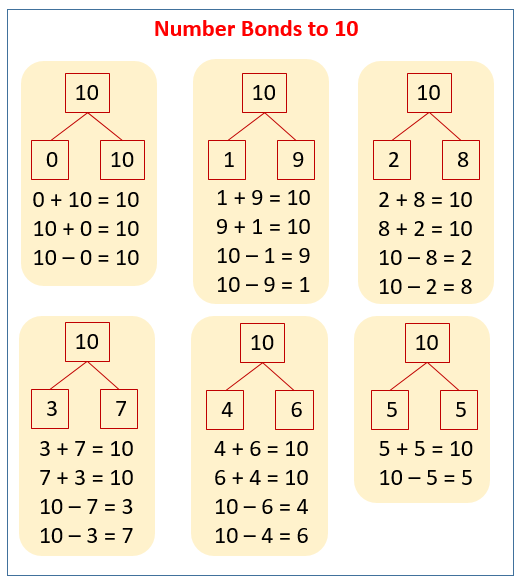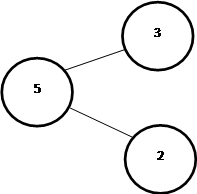Number Bonds to 10
Related Pages
More Singapore Math Lessons
Number Bond Games
These lessons, with videos, songs, examples, solutions, worksheets, games, and activities, help students learn number bonds in Singapore Math.
The following diagrams show to number bonds of 10. Scroll down the page for more examples and solutions.

Number Bonds Game/Worksheets
Practice your skills with the following game/worksheets:
Number Bonds Game
Printable & Online Number Bond Worksheets
What is a Number Bond?
Number bond is a concept used in Singapore Math and Common Core Math. It is a visual image that can be used to show the relationships between addition and subtraction.
A number bond consists of a minimum of three circles connected by lines. The “whole” is written in the first circle and its “parts” are written in the adjoining circles. The “parts” when added together will then equal the “whole”
The following number bond can be used to represent four number sentences.
3 + 2 = 5
2 + 3 = 5
5 − 3 = 2
5 − 2 = 3

Videos
Number Bonds (Singapore Math)
This video explains number bonds and how they can be used to make addition and subtraction number sentences.
Example:
5 + 3 = 8
3 + 5 = 8
8 - 5 = 3
8 - 3 = 5
Number Bonds
Introduction and tutorial for Kindergarten and First Grade.
Number Bonds within 10
Part-part whole model.
Numbers To 10: Making number bonds with cubes
The video shows how number bonds can be used to “split” numbers.
Songs for Number Bonds
Number Fun song that helps children understand Number Bonds to 10
Farmer Pete Number bond lyrics
Farmer Pete he had 10 sheep. All were in the pen.
10 were safe and none had gone. 10 add 0 makes 10.
“Oh dear!”, said Pete, “where is my sheep? There’s 9 here in the pen."
9 are safe and 1 has gone, 9 add 1 makes 10.
“Oh dear!”, said Pete, “where are my sheep? There’s 8 here in the pen."
8 are safe and 2 have gone, 8 add 2 makes 10.
“Oh dear!”, said Pete, “where are my sheep? There’s 7 here in the pen."
7 are safe and 3 have gone, 7 add 3 makes 10.
“Oh dear!”, said Pete, “where are my sheep? There’s 6 here in the pen."
6 are safe and 4 have gone, 6 add 4 makes 10.
“Oh dear!”, said Pete, “where are my sheep? There’s 5 here in the pen."
5 are safe and 5 have gone, 5 add 5 makes 10.
“Oh dear!”, said Pete, “where are my sheep? There’s 4 here in the pen."
4 are safe and 6 have gone, 4 add 6 makes 10.
“Oh dear!”, said Pete, “where are my sheep? There’s 3 here in the pen."
3 are safe and 7 have gone, 3 add 7 makes 10.
“Oh dear!”, said Pete, “where are my sheep? There’s 2 here in the pen."
2 are safe and 8 have gone, 2 add 8 makes 10.
“Oh dear!”, said Pete, “where are my sheep? There’s 1 here in the pen."
1 is safe and 9 have gone, 1 add 9 makes 10.
“Oh dear!”, said Pete, “where are my sheep? There’s none here in the pen."
None are safe and 10 have gone, 0 add 10 makes 10.
Farmer Pete Number bond song with lyrics and animation
What Makes Ten? - song
A song to help you learn what makes ten.
0 + 10 = 10
1 + 9 = 10
2 + 8 = 10
3 + 7 = 10
4 + 6 = 10
5 + 5 = 10
6 + 4 = 10
7 + 3 = 10
8 + 2 = 10
9 + 1 = 10
10 + 0 = 10
Number bonds are pairs of friends - number bonds to 10 song
Number bonds are pairs of friends
And all together they make ten
They will stick together until the end
They make ten! They make ten!
9 and 1 … Number bonds are fun
8 and 2 … Maths is good for you
7 and 3 … Sing along with me
6 and 4 … Let’s sing some more
5 and 5 … Makes me feel alive
4 and 6 … Numbers in the mix
3 and 7 … Number bond heaven
2 and 8 … Number bonds are great
1 and 9 … Counting all the time
5 and 5 … Makes me feel alive
Number Bonds in the Common Core Standards for mathematics education
This video is suitable for parents and teachers who want to find out more about the advantages of using number bonds.
Number bond is a representation that supports children in seeing composing-decomposing actions (a prerequisite skill for developing arithmetic strategies).
Advantages of Number Bonds
- Support learner’s attempts to ‘decontextualize’ the mathematical relationships embedded in words.
- Provides a graphic that helps learners see how quantities are related. (helps them see parts and whole)
- Serves as a ‘bridge’ between concrete representations and the more formal symbolic language of mathematics (equations)
- Can ‘grow’ with learner’s mathematical development (serves a future role as well)
Number bonds for additive relationships - one graphic effectively demonstrates the relationships between 3 whole numbers. They can be a useful tool in exploring the commutative property of addition.
Number bonds can be used to model number relationships and are useful representations for facilitating connections.
- Children learn to represent a mathematical situation with concrete materials.
- They learn to identify parts and whole through dialog with teachers and peers as the number bond is being constructed.
- They start to make number bonds on their own.
- They start to write equations for easiest problem types (result unknown / total unknown problems) after extensive teacher modeling.
Try out our new and fun Fraction Concoction Game.
Add and subtract fractions to make exciting fraction concoctions following a recipe. There are four levels of difficulty: Easy, medium, hard and insane. Practice the basics of fraction addition and subtraction or challenge yourself with the insane level.

We welcome your feedback, comments and questions about this site or page. Please submit your feedback or enquiries via our Feedback page.